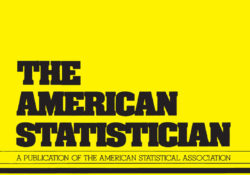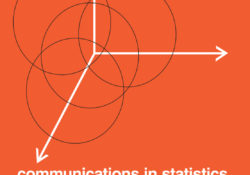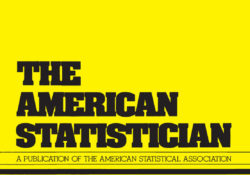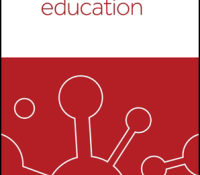tandfonline.com har udgivet en rapport under søgningen „Teacher Education Mathematics‟: AIC-type Theory-Based Model Selection for Structural Equation Models Link til kilde
Like this:
Like Loading...
tandfonline.com har udgivet en rapport under søgningen „Teacher Education Mathematics‟: Link til kilde
Like this:
Like Loading...
tandfonline.com har udgivet en rapport under søgningen „Teacher Education Mathematics‟: Abstract Formulae display:?Mathematical formulae have been encoded as MathML and are displayed in this HTML version using MathJax in order to improve their display. Uncheck the box to turn MathJax off. This feature requires Javascript. Click on a formula to zoom. Abstract Categorical scale data are only ordinal and defined on a finite set. Continuous scale data are only ordinal and defined on a bounded interval. Due to that character, the statistical methods for scale data ought to be based on orders between outcomes only and not any metric involving distance measure. For simple two-sample scale data, variants of classical rank methods are suitable. For regression type of problems, there are known good generalized linear models for separate categories for… Continue Reading →
Like this:
Like Loading...

tandfonline.com har udgivet en rapport under søgningen „Teacher Education Mathematics‟: Abstract Formulae display:?Mathematical formulae have been encoded as MathML and are displayed in this HTML version using MathJax in order to improve their display. Uncheck the box to turn MathJax off. This feature requires Javascript. Click on a formula to zoom. Abstract Statistical modeling continues to gain prominence in the secondary curriculum, and recent recommendations to emphasize data science and computational thinking may soon position algorithmic models into the school curriculum. Many teachers’ preparation for and experiences teaching statistical modeling have focused on probabilistic models. Subsequently, much of the research literature related to the teachers’ understanding has focused on probabilistic models. This study explores the extent to which secondary statistics teachers appear to understand ideas of statistical modeling, specifically the… Continue Reading →
Like this:
Like Loading...
tandfonline.com har udgivet en rapport under søgningen „Teacher Education Mathematics‟: Theories and Models: What They Are, What They Are for, and What They Are About Link til kilde
Like this:
Like Loading...
tandfonline.com har udgivet en rapport under søgningen „Teacher Education Mathematics‟: Link til kilde
Like this:
Like Loading...
tandfonline.com har udgivet en rapport under søgningen „Teacher Education Mathematics‟: Abstract Abstract The two parts in this special issue address interdisciplinary conversations involving mathematics courses in the first two years of undergraduate work. The special issue was inspired by work funded by the National Science Foundation under a grant titled “SUMMIT-P.” The special issue includes papers written about projects both from SUMMIT-P and from outside of SUMMIT-P. Part I focuses on frameworks and models of interdisciplinary collaboration. Link til kilde
Like this:
Like Loading...
tandfonline.com har udgivet en rapport under søgningen „Teacher Education Mathematics‟: Abstract Abstract Academic self-efficacy is mostly construed as specific; task-specific, course-specific or domain-specific. Previous research in the Danish university context has shown that the self-efficacy subscale in the Motivated Strategies for Leaning Questionnaire is not a single scale, but consists of two separate course- and activity-specific scales; the Specific Academic Learning Self-Efficacy Scale (SAL-SE) and the Specific Academic Exam Self-efficacy scale (SAE-SE). The SAL-SE and the SAE-SE subscales have previously been found to fit the Rasch model, have excellent reliability, and initial evidence of criterion validity has been established. The aim of this study was to conduct a new validity study of the SAL-SE and SAE-SE scales in the Danish university context. Specifically, whether the original findings of fit to… Continue Reading →
Like this:
Like Loading...
tandfonline.com har udgivet en rapport under søgningen „Teacher Education Mathematics‟: Abstract Formulae display:?Mathematical formulae have been encoded as MathML and are displayed in this HTML version using MathJax in order to improve their display. Uncheck the box to turn MathJax off. This feature requires Javascript. Click on a formula to zoom. Abstract The present study illustrates the utility of applying multilevel mixture models in educational research, using data on the homework behavior of 1,812 Swiss eighth-grade students in French as a second language. A previous person-centered study identified 5 homework learning types characterized by different patterns of high or low homework time and effort. Via multilevel latent profile analyses (MLPAs), the dependence of homework learning types on between-classroom differences was investigated. Based on the proportions of homework learning profiles across… Continue Reading →
Like this:
Like Loading...
tandfonline.com har udgivet en rapport under søgningen „Teacher Education Mathematics‟: ABSTRACT ABSTRACT This brief article introduces the topic of intelligence as highly appropriate for educational measurement professionals. It describes some of the uses of intelligence tests both historically and currently. It argues why knowledge of intelligence theory and intelligence testing is important for educational measurement professionals. The articles that follow in this special issue will provide readers with considerable information about the history of intelligence theory and testing, and especially of the Cattell-Horn-Carroll (CHC) model of testing and its implementation. The following articles will also provide a well-reasoned approach to the way science should work in evaluating tests and the models on which they are based. Link til kilde
Like this:
Like Loading...









